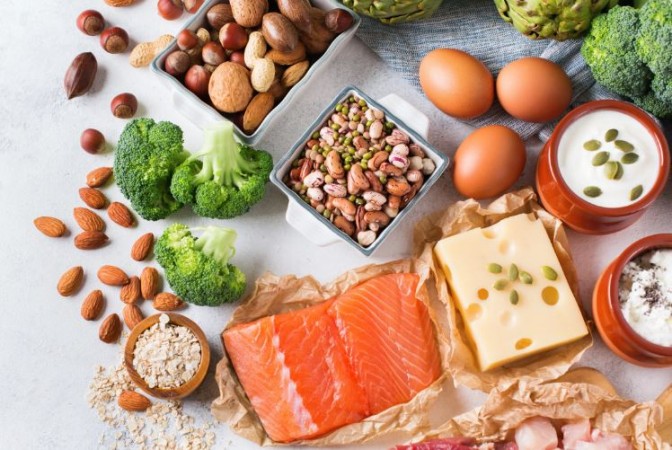
Protein is an essential macronutrient that plays a crucial role in various (how to get 50 grams protein) bodily functions, including muscle repair, immune system support, and hormone production. For individuals seeking to maintain or build muscle mass, a sufficient daily protein intake is of paramount importance. While protein supplements are popular, there is a plethora of natural food sources that can help you achieve your protein goals. In this article, we will explore a variety of everyday foods that can collectively provide around 50 grams of protein, giving you the (how to get 50 grams protein) information you need to make informed dietary choices.
Eggs: The Nutrient Powerhouse
Eggs are an excellent source of high-quality protein, boasting all essential amino acids required by the body. A single large egg contains approximately 6 grams of protein. Whether enjoyed as scrambled eggs for breakfast or hard-boiled as a convenient snack, incorporating eggs into your diet can contribute significantly to your protein intake.
Greek Yogurt: Creamy and Protein-Rich
Greek yogurt is renowned for its creamy texture and high protein content. A 6-ounce serving of plain Greek yogurt can provide around 15 grams of protein. This versatile dairy product can be consumed on its own, mixed with fruits and nuts, or added to smoothies for an added protein boost.
Chicken Breast: Lean and Protein-Packed
Chicken breast is a staple in many diets due to its lean protein content and versatility in cooking. A 4-ounce serving of cooked chicken breast offers roughly 30 grams of protein. Grilled, baked, or sautéed, chicken breast can be a centerpiece of a protein-rich meal.
Lentils: Plant-Based Protein Source
For those following a plant-based diet, lentils are a valuable protein source. Cooked lentils provide about 18 grams of protein per cup. Lentils can be added to soups, stews, salads, and curries, making them an excellent choice for both protein and fiber.
Tofu: Versatile and Protein-Packed
Tofu, derived from soybeans, is a versatile ingredient with approximately 10 grams of protein per 4-ounce serving. Its neutral taste allows it to be incorporated into various dishes, from stir-fries to smoothies. Tofu also absorbs the flavors of the seasonings and sauces used in cooking, making it adaptable to various cuisines.
Quinoa: The Complete Protein
Quinoa is a unique grain as it contains all nine essential amino acids, making it a complete protein source. One cup of cooked quinoa offers around 8 grams of protein. This grain can be used as a base for salads, mixed into breakfast bowls, or served as a side dish.
Cottage Cheese: Protein-Packed and Low-Fat
Cottage cheese is a dairy product known for its high protein content and low-fat nature. A 1-cup serving of low-fat cottage cheese provides approximately 28 grams of protein. It can be enjoyed on its own, mixed with fruits, or used as a topping for whole-grain crackers.
Almonds: Protein-Rich Nuts
Nuts, including almonds, offer a combination of protein, healthy fats, and essential nutrients. A 1-ounce serving of almonds contains about 6 grams of protein. Almonds make for a convenient and portable protein-rich snack.
Salmon: Omega-3s and Protein
Salmon is not only rich in protein but also a great source of omega-3 fatty acids. A 4-ounce serving of cooked salmon delivers around 25 grams of protein. Grilled, baked, or broiled, salmon can be a delectable way to meet your protein needs.
Black Beans: Fiber and Protein Combo
Black beans are another excellent plant-based protein source that also provides a healthy dose of dietary fiber. One cup of cooked black beans contains about 15 grams of protein. They can be used in salads, wraps, or blended into dips.
Combining for a Total of 50 Grams
Now that we've explored various individual sources of protein, let's consider how combining these foods in a day's meals can help you reach your target of 50 grams of protein:
Breakfast: Scrambled eggs (12g protein) with spinach and mushrooms, and a serving of Greek yogurt (15g protein).
Lunch: Grilled chicken breast (30g protein) over a quinoa (8g protein) and black bean salad.
Snack: A handful of almonds (6g protein).
Dinner: Baked salmon (25g protein) with a side of sautéed tofu (10g protein) and steamed vegetables.
Total protein intake: 106 grams
Meeting your daily protein intake goal of around 50 grams can (how to get 50 grams protein) be both delicious and achievable through a balanced diet that includes a variety of protein-rich foods. By incorporating sources such as eggs, Greek yogurt, chicken breast, lentils, tofu, quinoa, cottage cheese, almonds, salmon, and black beans, you can ensure that your body receives the amino acids it needs for optimal functioning. Remember that individual protein needs may vary based on factors such as age, activity level, and overall health goals. Always consult with a healthcare professional or registered dietitian before making significant changes to your diet.
Fertilizers for Kharif Planting; States Urged to Counter Urea Diversions: Mandaviya
Health Benefits of Bhutta During Rainy Days: 8 Reasons to Enjoy Corn Daily